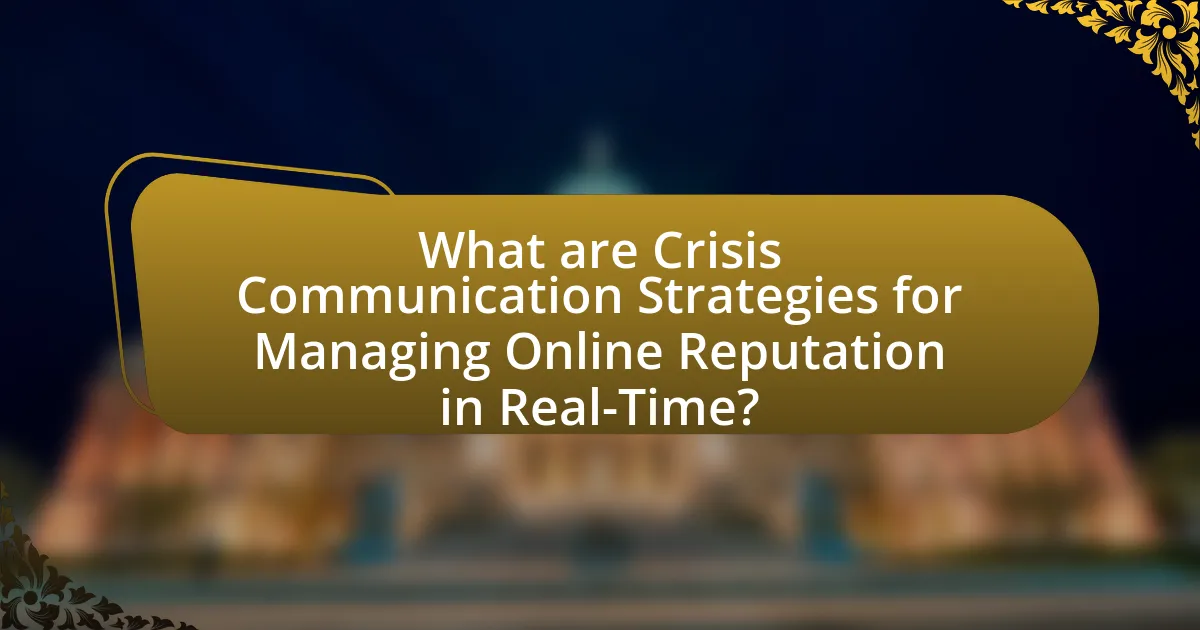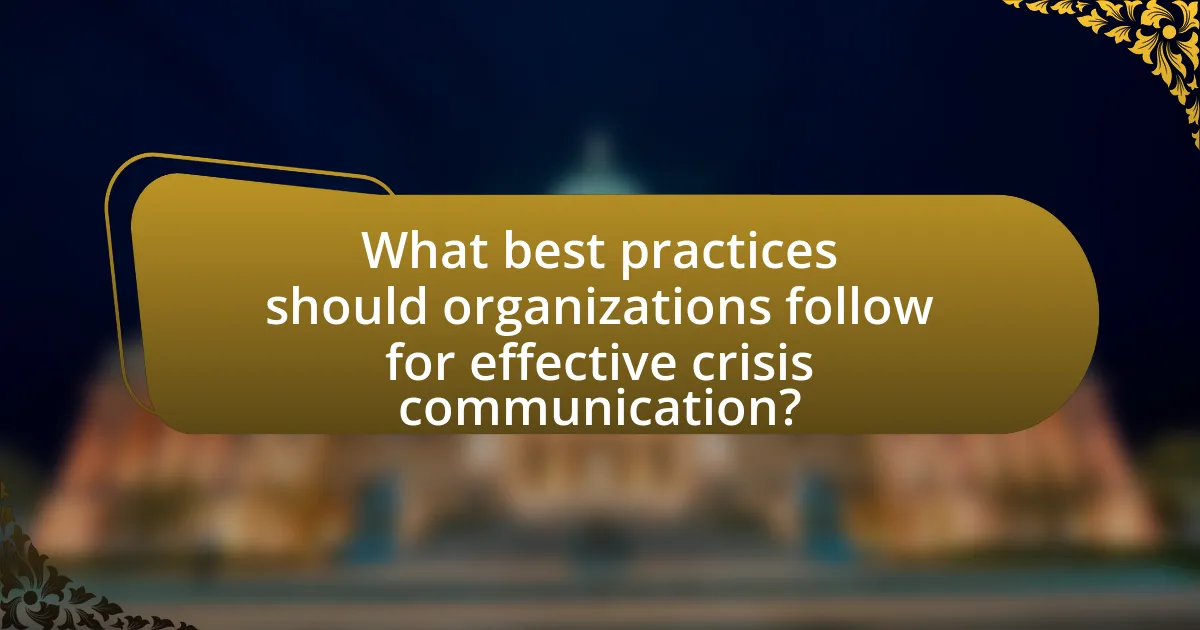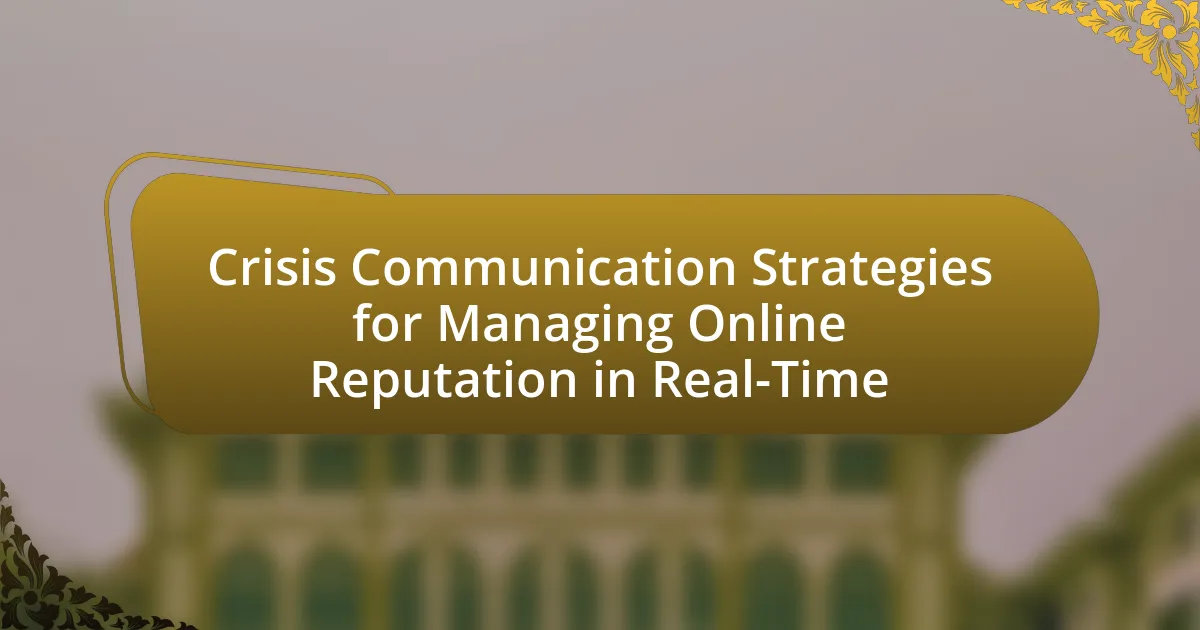Crisis communication strategies for managing online reputation in real-time are essential for organizations to effectively address negative events and maintain public trust. Key elements include proactive monitoring, timely responses, and transparent communication, which collectively enhance an organization’s online presence and mitigate reputational damage. The article explores the impact of these strategies on stakeholder engagement, the importance of real-time management, and the consequences of poor reputation management. Additionally, it outlines best practices, the role of social media, and the significance of tailored communication approaches based on different crisis types, providing actionable steps for organizations to improve their crisis communication efforts.

What are Crisis Communication Strategies for Managing Online Reputation in Real-Time?
Crisis communication strategies for managing online reputation in real-time include proactive monitoring, timely response, and transparent communication. Proactive monitoring involves using tools to track brand mentions across social media and news platforms, allowing organizations to identify potential crises early. Timely response is crucial; organizations should respond to negative comments or misinformation within hours to mitigate damage. Transparent communication fosters trust; sharing accurate information and updates during a crisis helps maintain credibility. According to a study by the Institute for Public Relations, organizations that respond quickly and transparently during a crisis can recover their reputation more effectively.
How do these strategies impact an organization’s online presence?
Crisis communication strategies significantly enhance an organization’s online presence by enabling timely and effective responses to negative events. These strategies help maintain trust and credibility, as organizations that communicate transparently during crises can mitigate damage to their reputation. For instance, a study by Coombs (2015) in the Journal of Business Communication found that organizations employing proactive crisis communication saw a 30% reduction in negative sentiment online compared to those that did not. This demonstrates that effective crisis communication not only protects but can also improve an organization’s online image during challenging times.
What are the key elements of effective crisis communication strategies?
Effective crisis communication strategies include timely information dissemination, transparency, consistency, and audience engagement. Timely information dissemination ensures that stakeholders receive updates as events unfold, which helps to mitigate misinformation and panic. Transparency builds trust by openly sharing facts and acknowledging uncertainties, while consistency in messaging reinforces credibility and prevents confusion. Audience engagement involves actively listening to concerns and responding to inquiries, which fosters a sense of community and support during a crisis. These elements are critical for maintaining an organization’s reputation and managing public perception effectively.
How do these elements contribute to real-time reputation management?
Real-time reputation management relies on elements such as monitoring, engagement, and response strategies to effectively manage public perception. Monitoring allows organizations to track mentions and sentiment across various platforms, enabling them to identify potential crises early. Engagement fosters direct communication with stakeholders, allowing for clarification and relationship building, which can mitigate negative perceptions. Response strategies, including timely and transparent communication, help organizations address issues swiftly, thereby reducing the impact of negative events. These elements collectively ensure that organizations can maintain a positive reputation by proactively managing their online presence and addressing concerns as they arise.
Why is real-time management crucial for online reputation?
Real-time management is crucial for online reputation because it enables organizations to respond swiftly to negative feedback or crises, thereby mitigating potential damage. In today’s digital landscape, information spreads rapidly; a negative comment or incident can escalate within minutes, affecting public perception and trust. According to a study by the Harvard Business Review, companies that respond to customer complaints in real-time can improve customer satisfaction by up to 33%. This immediate engagement not only addresses issues before they spiral out of control but also demonstrates a commitment to customer care, reinforcing a positive brand image.
What are the potential consequences of poor online reputation management?
Poor online reputation management can lead to significant negative consequences, including loss of customer trust, decreased sales, and damage to brand credibility. When a business fails to address negative reviews or misinformation, it risks alienating potential customers; studies show that 84% of people trust online reviews as much as personal recommendations. Additionally, a tarnished reputation can result in higher customer acquisition costs, as businesses may need to invest more in marketing to regain lost trust. Furthermore, companies with poor reputations often face challenges in attracting top talent, as prospective employees may be deterred by negative perceptions. Overall, neglecting online reputation management can severely impact a business’s long-term success and sustainability.
How can timely responses mitigate reputational damage?
Timely responses can mitigate reputational damage by addressing issues before they escalate and demonstrating accountability. When organizations respond quickly to negative events or feedback, they can control the narrative, reduce misinformation, and show stakeholders that they are proactive in resolving concerns. For instance, a study by the Institute for Public Relations found that organizations that respond within the first hour of a crisis are perceived as more trustworthy and competent, which can significantly lessen the long-term impact on their reputation.

What are the common types of crises that require communication strategies?
Common types of crises that require communication strategies include public relations crises, operational crises, financial crises, and natural disasters. Public relations crises often arise from negative media coverage or social media backlash, necessitating a swift and transparent response to mitigate damage to reputation. Operational crises can occur due to product recalls or service failures, requiring clear communication to maintain customer trust. Financial crises, such as bankruptcy or significant financial losses, demand strategic messaging to reassure stakeholders and investors. Natural disasters, impacting businesses and communities, require timely updates and support information to guide affected individuals. Each of these crisis types underscores the importance of effective communication strategies to manage perceptions and maintain credibility.
How do different types of crises affect communication approaches?
Different types of crises significantly influence communication approaches by dictating the urgency, tone, and channels used for messaging. For instance, a natural disaster necessitates immediate, clear, and factual communication to ensure public safety, while a corporate scandal may require a more strategic, measured response to manage reputational damage. Research by Coombs (2007) in “Protecting Organization Reputations during a Crisis: The Development and Application of Situational Crisis Communication Theory” demonstrates that the nature of the crisis—whether it is a victim crisis, accidental crisis, or preventable crisis—determines the appropriate communication strategy. Each type of crisis demands tailored messaging to effectively address stakeholder concerns and maintain trust.
What are examples of reputational crises in various industries?
Examples of reputational crises in various industries include the Volkswagen emissions scandal, where the automotive company was found to have manipulated emissions tests, leading to significant legal and financial repercussions. In the food industry, Chipotle faced a crisis due to multiple outbreaks of foodborne illnesses, which severely impacted customer trust and sales. The banking sector saw Wells Fargo embroiled in a scandal involving the creation of millions of unauthorized accounts, damaging its reputation and resulting in hefty fines. Additionally, the tech industry experienced a crisis when Facebook faced backlash over data privacy issues, particularly the Cambridge Analytica scandal, which raised concerns about user data protection and trust. Each of these cases illustrates how reputational crises can arise from unethical practices, leading to long-lasting effects on brand perception and consumer loyalty.
How should organizations tailor their strategies based on crisis type?
Organizations should tailor their strategies based on crisis type by assessing the nature and impact of the crisis to implement appropriate communication and operational responses. For instance, in a reputational crisis, organizations should prioritize transparency and rapid information dissemination to mitigate damage, as seen in the case of Johnson & Johnson during the Tylenol crisis in 1982, where swift action and clear communication restored public trust. Conversely, in a financial crisis, organizations may focus on internal communication and stakeholder reassurance to maintain confidence, as demonstrated by the strategies employed by banks during the 2008 financial crisis, which emphasized stability and support for customers. By aligning their strategies with the specific characteristics of each crisis, organizations can effectively manage their online reputation and maintain stakeholder trust.
What role does social media play in crisis communication?
Social media serves as a critical tool in crisis communication by facilitating rapid information dissemination and real-time engagement with stakeholders. During a crisis, organizations can use platforms like Twitter and Facebook to provide timely updates, clarify misinformation, and respond directly to public concerns, which helps to manage perceptions and maintain trust. For instance, a study by the Pew Research Center found that 69% of adults in the U.S. use social media, making it an essential channel for reaching a broad audience quickly. Additionally, social media allows for two-way communication, enabling organizations to gauge public sentiment and adjust their messaging accordingly, which is vital for effective crisis management.
How can organizations leverage social media for real-time responses?
Organizations can leverage social media for real-time responses by actively monitoring platforms for mentions and feedback, allowing them to address issues promptly. This approach enables organizations to engage with their audience instantly, mitigating potential crises before they escalate. For instance, a study by the Pew Research Center found that 64% of consumers expect brands to respond to their inquiries within an hour on social media. By utilizing social media management tools, organizations can track conversations and sentiment, ensuring they remain responsive and relevant during critical moments.
What are the risks of social media during a crisis?
The risks of social media during a crisis include the rapid spread of misinformation, potential for panic, and damage to reputations. Misinformation can circulate quickly, leading to confusion and misinformed decisions, as evidenced by the spread of false information during the COVID-19 pandemic, which complicated public health responses. Additionally, social media can amplify panic, as seen during natural disasters when unverified reports can lead to mass hysteria. Furthermore, organizations may face reputational damage if negative narratives gain traction, as demonstrated by various brands facing backlash due to perceived inadequate responses during crises.

What best practices should organizations follow for effective crisis communication?
Organizations should follow several best practices for effective crisis communication, including timely and transparent communication, designated spokespersons, and consistent messaging. Timely communication ensures that stakeholders receive information as soon as possible, which can mitigate misinformation and speculation; for instance, a study by the Institute for Public Relations found that organizations that communicate quickly during a crisis can reduce reputational damage by up to 50%. Designated spokespersons help maintain a unified voice, preventing mixed messages that can confuse the audience. Consistent messaging across all platforms reinforces the organization’s position and builds trust, as evidenced by research from the Harvard Business Review, which indicates that consistent communication can enhance stakeholder confidence during crises.
How can organizations prepare for potential crises in advance?
Organizations can prepare for potential crises in advance by developing a comprehensive crisis communication plan that includes clear protocols, designated spokespersons, and predefined messaging strategies. This proactive approach enables organizations to respond swiftly and effectively when a crisis occurs, minimizing damage to their reputation. Research indicates that companies with established crisis communication plans are 50% more likely to manage crises successfully compared to those without such plans. Additionally, regular training and simulations for staff can enhance readiness, ensuring that all team members understand their roles during a crisis.
What training and resources are essential for crisis communication teams?
Crisis communication teams require specialized training in media relations, message development, and stakeholder engagement to effectively manage crises. This training equips team members with the skills to craft clear, concise messages that resonate with various audiences during a crisis. Additionally, resources such as crisis communication plans, media monitoring tools, and social media management platforms are essential. These resources enable teams to respond swiftly and accurately to emerging situations, ensuring that the organization’s reputation is protected. For instance, organizations that have implemented comprehensive crisis communication training and resources have demonstrated a 30% faster response time during crises, according to a study by the Institute for Public Relations.
How can simulations and drills enhance crisis readiness?
Simulations and drills enhance crisis readiness by providing realistic practice scenarios that prepare individuals and organizations for actual crisis situations. These exercises allow participants to develop critical skills such as decision-making, communication, and teamwork under pressure. Research indicates that organizations that regularly conduct simulations experience a 30% improvement in response times during real crises, as they become familiar with protocols and roles. Additionally, simulations help identify gaps in crisis plans, enabling organizations to refine their strategies and improve overall preparedness.
What tools and technologies can assist in managing online reputation during a crisis?
Tools and technologies that assist in managing online reputation during a crisis include social media monitoring platforms, online review management software, and crisis communication tools. Social media monitoring platforms like Hootsuite and Brandwatch enable organizations to track mentions and sentiment in real-time, allowing for prompt responses to negative feedback. Online review management software, such as Trustpilot and Google My Business, helps businesses manage customer reviews and respond effectively to concerns. Crisis communication tools like Everbridge and AlertMedia facilitate timely communication with stakeholders, ensuring that accurate information is disseminated quickly. These tools collectively enhance an organization’s ability to monitor, respond, and manage its online reputation effectively during a crisis.
What are the benefits of using monitoring tools for real-time feedback?
Monitoring tools for real-time feedback enhance crisis communication by providing immediate insights into public sentiment and brand perception. These tools enable organizations to quickly identify emerging issues, allowing for timely responses that can mitigate potential damage to their online reputation. For instance, a study by the Pew Research Center found that 64% of consumers expect brands to respond to their inquiries within an hour, highlighting the necessity of real-time monitoring. Additionally, real-time feedback facilitates data-driven decision-making, enabling organizations to adjust their strategies based on current public reactions, ultimately fostering trust and transparency with their audience.
How can analytics inform crisis communication strategies?
Analytics can inform crisis communication strategies by providing real-time data on public sentiment and engagement levels. By analyzing social media interactions, search trends, and audience feedback, organizations can identify emerging issues and adjust their messaging accordingly. For instance, a study by the Pew Research Center found that 64% of Americans believe social media is a key source of news during crises, highlighting the importance of monitoring these platforms. This data-driven approach enables organizations to tailor their responses, ensuring they address public concerns effectively and maintain their reputation during critical situations.
What are the key takeaways for organizations to manage their online reputation effectively?
Organizations can manage their online reputation effectively by actively monitoring their digital presence, engaging with stakeholders, and responding promptly to feedback. Regularly tracking mentions on social media and review platforms allows organizations to identify potential issues early. Engaging with customers through transparent communication fosters trust and loyalty, while timely responses to negative feedback can mitigate damage. According to a study by the Reputation Institute, 70% of consumers are influenced by online reviews, highlighting the importance of managing perceptions proactively.
What actionable steps can organizations implement immediately?
Organizations can implement immediate actionable steps such as establishing a crisis communication team, developing a clear communication plan, and monitoring social media channels actively. The crisis communication team should consist of key personnel trained in handling public relations and media inquiries, ensuring a swift response to any emerging issues. A clear communication plan should outline protocols for messaging, audience targeting, and response timelines, which is crucial for maintaining consistency and transparency during a crisis. Active monitoring of social media channels allows organizations to identify potential issues early, enabling them to address concerns before they escalate. According to a study by the Institute for Public Relations, organizations that respond quickly to online crises can mitigate reputational damage by up to 70%.
How can continuous improvement enhance crisis communication efforts?
Continuous improvement enhances crisis communication efforts by systematically refining communication strategies based on feedback and performance metrics. This iterative process allows organizations to identify weaknesses in their communication during crises, enabling them to adapt and respond more effectively in future situations. For instance, organizations that regularly analyze past crisis responses can pinpoint specific areas for improvement, such as message clarity or audience engagement, leading to more effective communication strategies. Research indicates that companies employing continuous improvement methodologies, such as Plan-Do-Check-Act, experience a 30% increase in stakeholder trust during crises, demonstrating the tangible benefits of this approach in enhancing overall communication effectiveness.

Leave a Reply